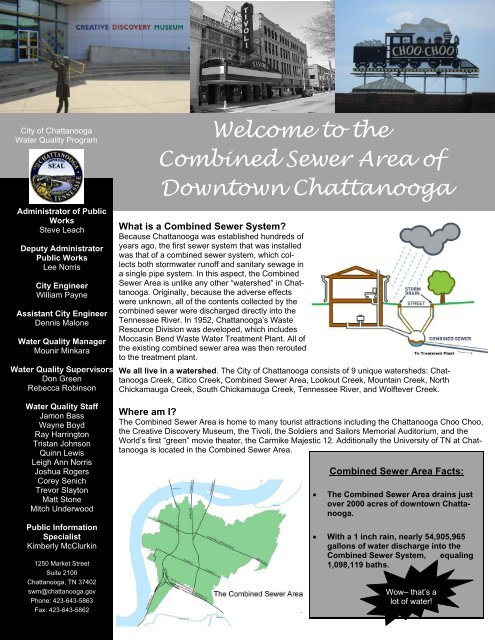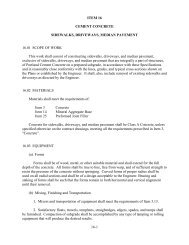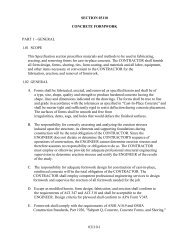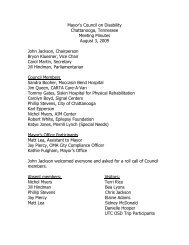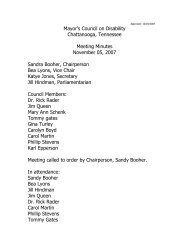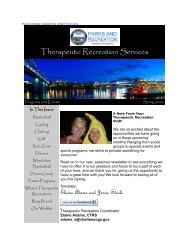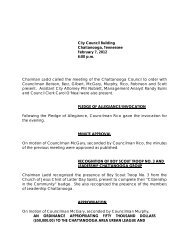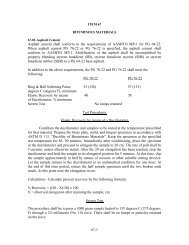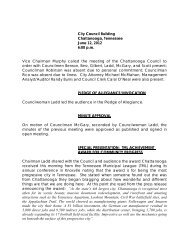Welcome to the Combined Sewer Area of Downtown Chattanooga
Welcome to the Combined Sewer Area of Downtown Chattanooga
Welcome to the Combined Sewer Area of Downtown Chattanooga
You also want an ePaper? Increase the reach of your titles
YUMPU automatically turns print PDFs into web optimized ePapers that Google loves.
City <strong>of</strong> <strong>Chattanooga</strong>Water Quality ProgramAdministra<strong>to</strong>r <strong>of</strong> PublicWorksSteve LeachDeputy Administra<strong>to</strong>rPublic WorksLee NorrisCity EngineerWilliam PayneAssistant City EngineerDennis MaloneWater Quality ManagerMounir MinkaraWater Quality SupervisorsDon GreenRebecca RobinsonWater Quality StaffJamon BassWayne BoydRay Harring<strong>to</strong>nTristan JohnsonQuinn LewisLeigh Ann NorrisJoshua RogersCorey SenichTrevor Slay<strong>to</strong>nMatt S<strong>to</strong>neMitch UnderwoodPublic InformationSpecialistKimberly McClurkin1250 Market StreetSuite 2100<strong>Chattanooga</strong>, TN 37402swm@chattanooga.govPhone: 423-643-5863Fax: 423-643-5862<strong>Welcome</strong> <strong>to</strong> <strong>the</strong><strong>Combined</strong> <strong>Sewer</strong> <strong>Area</strong> <strong>of</strong>Down<strong>to</strong>wn <strong>Chattanooga</strong>What is a <strong>Combined</strong> <strong>Sewer</strong> System?Because <strong>Chattanooga</strong> was established hundreds <strong>of</strong>years ago, <strong>the</strong> first sewer system that was installedwas that <strong>of</strong> a combined sewer system, which collectsboth s<strong>to</strong>rmwater run<strong>of</strong>f and sanitary sewage ina single pipe system. In this aspect, <strong>the</strong> <strong>Combined</strong><strong>Sewer</strong> <strong>Area</strong> is unlike any o<strong>the</strong>r “watershed” in <strong>Chattanooga</strong>.Originally, because <strong>the</strong> adverse effectswere unknown, all <strong>of</strong> <strong>the</strong> contents collected by <strong>the</strong>combined sewer were discharged directly in<strong>to</strong> <strong>the</strong>Tennessee River. In 1952, <strong>Chattanooga</strong>’s WasteResource Division was developed, which includesMoccasin Bend Waste Water Treatment Plant. All <strong>of</strong><strong>the</strong> existing combined sewer area was <strong>the</strong>n rerouted<strong>to</strong> <strong>the</strong> treatment plant.We all live in a watershed. The City <strong>of</strong> <strong>Chattanooga</strong> consists <strong>of</strong> 9 unique watersheds: <strong>Chattanooga</strong>Creek, Citico Creek, <strong>Combined</strong> <strong>Sewer</strong> <strong>Area</strong>, Lookout Creek, Mountain Creek, NorthChickamauga Creek, South Chickamauga Creek, Tennessee River, and Wolftever Creek.Where am I?The <strong>Combined</strong> <strong>Sewer</strong> <strong>Area</strong> is home <strong>to</strong> many <strong>to</strong>urist attractions including <strong>the</strong> <strong>Chattanooga</strong> Choo Choo,<strong>the</strong> Creative Discovery Museum, <strong>the</strong> Tivoli, <strong>the</strong> Soldiers and Sailors Memorial Audi<strong>to</strong>rium, and <strong>the</strong>World’s first “green” movie <strong>the</strong>ater, <strong>the</strong> Carmike Majestic 12. Additionally <strong>the</strong> University <strong>of</strong> TN at <strong>Chattanooga</strong>is located in <strong>the</strong> <strong>Combined</strong> <strong>Sewer</strong> <strong>Area</strong>.<strong>Combined</strong> <strong>Sewer</strong> <strong>Area</strong> Facts:The <strong>Combined</strong> <strong>Sewer</strong> <strong>Area</strong> drains jus<strong>to</strong>ver 2000 acres <strong>of</strong> down<strong>to</strong>wn <strong>Chattanooga</strong>. With a 1 inch rain, nearly 54,905,965gallons <strong>of</strong> water discharge in<strong>to</strong> <strong>the</strong><strong>Combined</strong> <strong>Sewer</strong> System, equaling1,098,119 baths.Wow– that’s alot <strong>of</strong> water!
Water Quality Issues in <strong>the</strong><strong>Combined</strong> Sanitary <strong>Sewer</strong> <strong>Area</strong> Pathogens Urban influences (i.e. trash,pet waste, grass clippings,mo<strong>to</strong>r oil, and gasoline)What is <strong>the</strong> City doing <strong>to</strong> manage <strong>the</strong> water qualityissues in <strong>the</strong> <strong>Combined</strong> <strong>Sewer</strong> <strong>Area</strong>?S<strong>to</strong>rmwater Management — A 300,000 gallon underground s<strong>to</strong>rmwater reservoir was constructed underneath Martin Lu<strong>the</strong>r King Boulevard, allowingexcess s<strong>to</strong>rmwater from large rain events <strong>to</strong> be temporarily s<strong>to</strong>red. This reduces <strong>the</strong> amount <strong>of</strong> s<strong>to</strong>rmwater in<strong>the</strong> combined sewer which, in turn, helps <strong>to</strong> reduce <strong>the</strong> number <strong>of</strong> Sanitary <strong>Sewer</strong> Overflows (SSOs). The untreatedsewage from <strong>the</strong>se overflows contaminates our waters, causing serious water quality problems.<strong>Chattanooga</strong>’s Urban Forestry Department and Take Root have planted over 600 trees in down<strong>to</strong>wn <strong>Chattanooga</strong>,increasing s<strong>to</strong>rmwater management, reducing run<strong>of</strong>f, decreasing urban heat islands and improving both air and waterquality.The Creative Discovery Museum has a 3000 square foot garden consisting <strong>of</strong> sedum plants, pansies, planting boxescontaining a variety <strong>of</strong> o<strong>the</strong>r small plants, and even small trees.What can I do <strong>to</strong> improve water quality in <strong>the</strong> <strong>Combined</strong> <strong>Sewer</strong> <strong>Area</strong>?Maintain vehicles <strong>to</strong> reduce <strong>the</strong> discharge <strong>of</strong> oil and o<strong>the</strong>r mo<strong>to</strong>r fluids <strong>to</strong> <strong>the</strong> watershed.Wash cars in grassy areas <strong>to</strong> prevent run<strong>of</strong>f <strong>of</strong> washing chemicals in<strong>to</strong> <strong>the</strong> s<strong>to</strong>rm drains.Do not discard your used mo<strong>to</strong>r oil, leaves, paint, or anything else in<strong>to</strong> s<strong>to</strong>rm drains.To avoid blockages in your sanitary service line, pour grease and/or cooking oil in closed containers <strong>to</strong> be disposed<strong>of</strong> in your trash cans instead <strong>of</strong> in <strong>the</strong> sink.Pick-up after your pet <strong>to</strong> reduce pathogens in <strong>the</strong> watershed.Properly dispose <strong>of</strong> your grass clippings/wood debris through compositing or <strong>the</strong> brush pick-up service <strong>of</strong>fered by <strong>the</strong>City.Use mulch <strong>to</strong> control weeds instead <strong>of</strong> pesticides.Consider installing a rain barrel or rain garden.Disconnect your downspouts.To report an illicit discharge: Call 311 or email: swm@chattanooga.govAdditional Resources:TN Department <strong>of</strong> Environment & Conservation (TDEC): www.state.tn.us/environment/wpc/Environmental Protection Agency (EPA): www.epa.gov/owow/watershed/Center for Watershed Protection: http://www.cwp.org/


